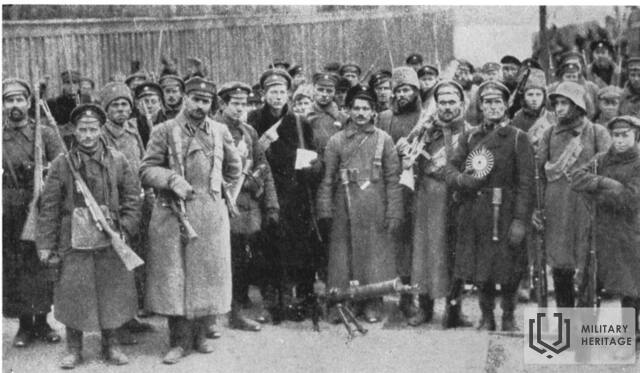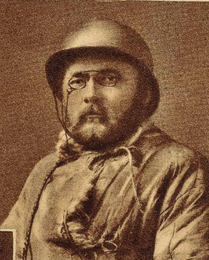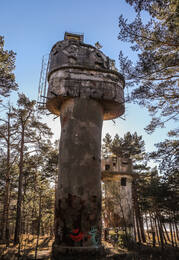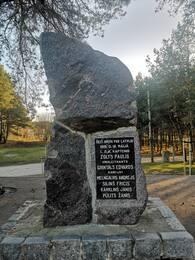South Latvian Brigade or Separate Latvian Brigade
I Wars of Independence

The Southern Latvian Brigade or Separate Latvian Brigade was a part of the Latvian Landesveer (Home Guard) troops, which after the victory in the Battle of Cēsis and the Armistice of Strazdumuiža on July 10, 1919, was merged with the Northern Latvian Brigade and the Baltic German Home Guard, forming the Latvian Armed Forces (Latvian Army).
On March 21, 1919, in Liepāja, the Minister of Security of the Latvian Provisional Government, Jānis Zālītis, issued Order No. 21, by which the Latvian Separate Battalion was renamed the Southern Group of the Latvian Army with the organization of a separate brigade from infantry companies, a sapper company and a commanding artillery unit. The brigade was commanded by Jānis Balodis, who was promoted to colonel by this order, effective March 14.
The Southern Latvian Brigade continued to participate in the liberation of Kurzeme and Zemgale from the Bolsheviks. On May 18, 1919, in the battle near Kaugurciems, Captain Pauls Zolts' company forced two Bolshevik regiments to retreat from their positions, and as a result of the victory, the Latvian separate brigade units liberated the territory of present-day Jūrmala, and on May 22, the brigade participated in the liberation of Pinki, and on May 23, it entered Riga. After the liberation of Riga, the brigade continued to be replenished with new units. The brigade did not directly participate in the battles of Cēsis.
In July 1919, when a unified Latvian army was formed, the South Latvian Brigade was transformed into the Courland Division.
More information sources
Order (No. 21) of the Minister of Security of the Provisional Government of Latvia, J. Zālītis, on the confirmation of General J. Baložs as commander of the Latvian Separate Battalion and its renaming as the Southern Group of the Latvian Army. https://web.archive.org/web/20070531202113/http://www.historia.lv/alfabets/L/la/lat_atsev_bat/dok/1919.03.21.htm
Southern Latvian Brigade. Wikipedia. https://lv.wikipedia.org/wiki/Dienvidlatvijas_brig%C4%81de
Ēriks Jēkabsons. Latvian War of Independence. The struggle of the Latvian Provisional Government and its armed forces to ensure the independence of Latvia from 18.11.1918 to 11.08.1920. – National Encyclopedia: https://enciklopedija.lv/skirklis/22216-Latvijas-Neatkar%C4%ABbas-kar%C5%A1
The Fight for Freedom: The Latvian War of Independence (1918–1920) in the Documents of the Latvian State Historical Archive, Part 1, November 18, 1918–April 16, 1919, comp. Ē. Jēkabsons and J. Šiliņš, Riga, Latvian National Archives, 2019.
“Fight for Freedom: The Latvian War of Independence (1918–1920) in the Documents of the Latvian State Historical Archive” Part 2. April 16–July 10, 1919, comp. Ē. Jēkabsons and J. Šiliņš, Riga, Latvian National Archives, 2019.
Related objects
Individual burial of LKOK captain Pauls Zolts at the Mazsalaca cemetery
Located in the Mazsalaca cemetery
The individual burial of Captain Pauls Zolts (1880-1919) can be viewed.
On September 9, 1934, a black granite tombstone with text was unveiled on Zolts' grave.
Captain Zolts' name is also engraved on a monument in Kaugurciems, where a total of six soldiers from the 2nd or P.Zolts Company of the Separate Student Battalion fell in the battle of May 18, 1919.
Captain Paulis Zolts, commander of the 2nd Company of the Separate Student Battalion of the Latvian Separate Brigade, who fell near Kaugurciems on May 18, 1919, was initially buried in the fraternal cemetery near the Ķemeri Lutheran Church. On May 18, 1920, his remains were exhumed and transferred to Mazsalaca, where they were laid to rest in the family cemetery on May 25.
Karosta, the Military port of Liepāja (tour)
The Karosta is the largest historical military territory in the Baltics and occupies almost one third of the entire territory of Liepāja. The Karosta is a unique compound of military and fortification buildings on the shores of the Baltic Sea with a special meaning in the history and architecture of Latvia and the world. The Karosta features such military heritage sites as the North Pier and forts, the Redan, Karosta Prison, Karosta Water Tower, St. Nicholas Orthodox Maritime Cathedral, Oskars Kalpaks Bridge and others.
Monument to Captain Zolt and student soldiers
Located in the city of Jurmala, Sloka, on the Gulf of Riga, in the Kaugurciems dunes.
The memorial was erected in 1934, destroyed during the Soviet occupation, but restored in 1989. In Kaugurciems, on the morning of May 18, 1919, a battle took place between the Latvian National Force, a company led by Captain Paulis Zolts (~145 men), and the Red Army troops. The event is special in that the battle took place in the most adverse conditions, demonstrating military courage and faith in the Latvian state.
During the night before the battle, a storm broke out, and sand covered the positions and weapons. In addition, inadequate ammunition was received. When the enemy attacked, Captain Zolts' soldiers counterattacked at the decisive moment, using rifle bayonets and winning the victory.
Zolts was an experienced Latvian officer who had participated in the Russo-Japanese War, World War I, and the Latvian War of Independence. His brother was also a soldier, while his son, as a medical student during World War II, was a medic in the Latvian Legion of the German army, and fell while carrying a seriously wounded soldier from his positions.
Today, you can visit a memorial site built on the site of the battle. Nearby, there is a beautiful seaside forest and the sea, allowing you to learn about history in a pleasant environment.
Memorial stone at the battle site of General Jānis Baložs' brigade
The memorial stone at the site of the battle of General Jānis Baložs' brigade is located in the forest near the Riga - Liepāja (A9) highway, near the Batari house.
The memorial stone was unveiled in 1936 with a solemn ceremony attended by the then Minister of Transport B. Einbergs and other high-ranking Riga officials and the public of Džūkste parish, commemorating the battle that took place here on March 22, 1919. The inscription engraved on the monument reads: “Here, on March 22, 1919, the battle of the 1st Separate Baloži Brigade took place, in which 10 soldiers fell and 28 were wounded.”
The battle took place between the Separate Latvian Brigade and the 10th Soviet Latvian Rifle Regiment, which consisted of 90 percent Latvians. During the freedom struggle, it was one of those battles in which Latvians fought against Latvians. The Bolsheviks had established themselves in the Batari houses. They began to fire on the brigade soldiers who were heading in the direction of Kalnciems. As the fire intensified, the brigade deployed for battle. The main burden of the battle was borne by the Separate Student Company and the Latvian Independence Battalion. As the battle dragged on, a platoon of the student company and the newly formed company of Captain E. Graudiņš, while performing a bypass maneuver, collided in the forest with the enemy, who was performing a similar maneuver. In a fierce battle, which in some places turned into close combat, the enemy was defeated. At this time, the German Miller battery assigned to the brigade opened fire on the Batari houses. After artillery fire, the brigade drove the enemy from his positions in a swift attack.
The newspaper “Brīvā Zeme” (18.05. 1936) published the memories of a former fighter: “The brigade’s cavalry had just ridden out into the open, when they were met by heavy enemy fire. After that, it was clear that they were dealing with very strong enemy forces. The battalions, on the orders of General J. Baložs, deployed and began to fight, getting into close combat, as the bayonets of the brigade’s soldiers decided this two-hour battle into a brilliant victory for the Kalpakians. This battle was of great importance, because it leveled the situation on the front, which had become unsafe because of the Germans, and ensured that the Red Riflemen’s regiments no longer entered the Zemgale Plain.”
General J. Baložs' brigade won the battle, losing 10 soldiers, including Kārlis Barons (1900.8.III – 1919.22.III), the grandson of the father of the Dainas, Krišjānis Barons, who is buried in the Riga Brothers' Cemetery. 50 soldiers of the Soviet Latvian Riflemen Regiment fell in the battle.
Related stories
The beginning, course and conclusion of the Battle of Cēsis
The victory in the Battle of Cēsis was destined to become a turning point in the Latvian and Estonian struggle for the independence of their country. This victory put an end to the plans of the Andrievs Niedra government and the German general Rüdiger von der Goltz to conquer the Baltics. Instead, the Latvian Provisional Government of Kārlis Ulmanis resumed its activities in Liepāja.
About the first Commander-in-Chief of the Latvian Army, Dāvids Sīmansons
The essays in the book "Commanders of the Latvian Army" convince us that history is significantly influenced by specific individuals. Although they were at the epicenter of the most important historical events for a short time, true Latvian patriots, with their rich military experience, managed to do a lot in the formation and strengthening of the Latvian army and in the turning points of historical events.
This story is about the first Commander-in-Chief of the Latvian Army, Dāvids Sīmansons (1859-1933).








